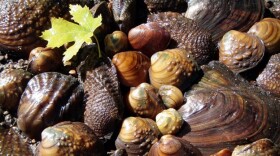Do you remember how hot it was in some parts of the US this summer? One day, the ocean water – the ocean water – near Miami was 101 degrees. Global warming isn’t coming – it is here. Global warming may also be affecting a global water circulation system abbreviated AMOC that includes the Gulf Stream, that river of ocean water that moves warm tropical water north along the east coast of North America before veering off toward Europe. As it approaches its northern end, the water starts to cool, where normally it would sink deep under the surface before continuing south to complete its route. But global warming is causing massive melting of the Greenland glaciers creating the “cold blob”, a pool of cold, fresh meltwater floating on top of the ocean water. The cold blob is right about where the Gulf Stream water usually takes its nosedive into the deep, possibly preventing it from continuing its circuit. An interruption, or halt of the Gulf Stream would have massive climatic effects on many parts of the world, with some areas becoming colder and others much drier.
The currents are complex and there is not universal agreement on when this could happen. But lake enthusiasts can appreciate why this might be happening. Although lake water doesn’t move like the Gulf Stream, our northern lakes go through an annual circulation pattern known as turnover and this is also governed by the fact that cold water is denser than warm water. In winter, the ice, being less dense than water, floats on top of the lake. In spring, the ice melts, and cold meltwater, being denser than the underlying warmer water, sinks toward the bottom. The slightly warmer water on the bottom (yes – in winter the warmest lake water is on the bottom) is pushed up toward the surface. For a short time in spring, the lake will be the same temperature top to bottom. The summer sun beats down, and the surface water begins to warm, creating a warm layer of water floating on top of a cold bottom layer. In the fall, the surface water cools and sinks again. Again, there will be a short time in the fall when the lake is the same temperature top to bottom. When winter arrives, the surface water freezes, and the ice once again floats on top of the lake.
While it is true that cold water is denser than warm water, it is also true that salt water is denser than fresh water. In March, our lab at Trout Lake Station entertains a classroom of fourth graders with a days’ worth of lake activities. To convey the notion of lake turnover to these youngsters, we have an activity that remarkably captures what is going on with the interruption of the Gulf Stream by fresh water. We help them discover that water of different densities can form layers. I prepare three bottles of different colored water. The red one has lots of salt dissolved in it, the yellow one has about half the salt and the green one has no salt. This means the different colors have different densities – the more salt, the denser. I give them a tube and pipette (a very small turkey baster) and they are instructed to put one pipette-full of one of the colors, let’s say they put the red into the tube first. Then they are told to add, on top of the first color, a pipette-full of a second color, let’s say they chose the yellow. They find that the yellow floats on top, and I instruct them to write down their results: red is heavier than yellow. They dump out those two colors and continue with all pairs of colors until they have tried all the combinations. Eventually, and with some thinking, they will figure out the puzzle. Then they put all three colors in the tube, in order of density, and they get a nice rainbow of colors in their tube.
And what was on top? It was the green water, with no salt, a.k.a. fresh water. This is like the cold blob near Greenland floating on top of the salty Gulf Stream. The freshwater of the cold blob acts like a traffic cop at a busy intersection, that isn’t letting any of the Gulf Stream continue on its way.
And while the science is not conclusive, there is good evidence the Gulf Stream will slow if warming continues. I hope our fourth graders will learn this lesson, and that some of them will grow up to help figure out how to get us out of this mess.









